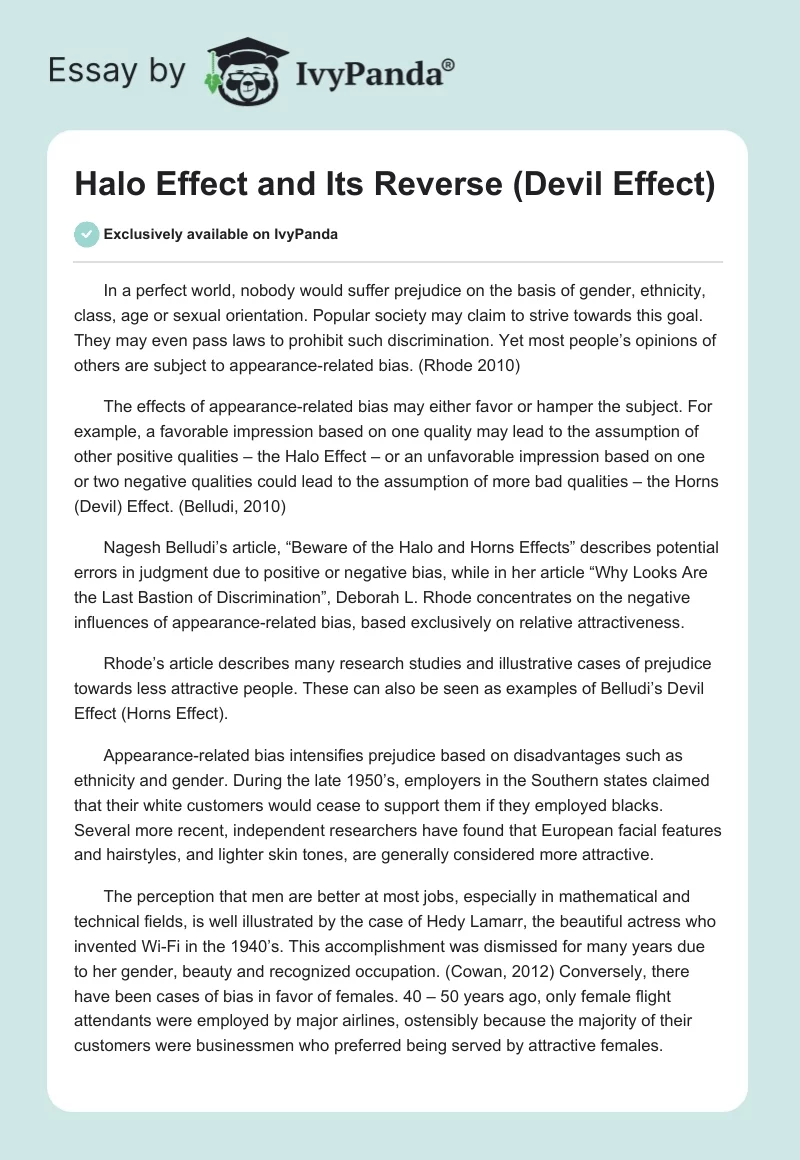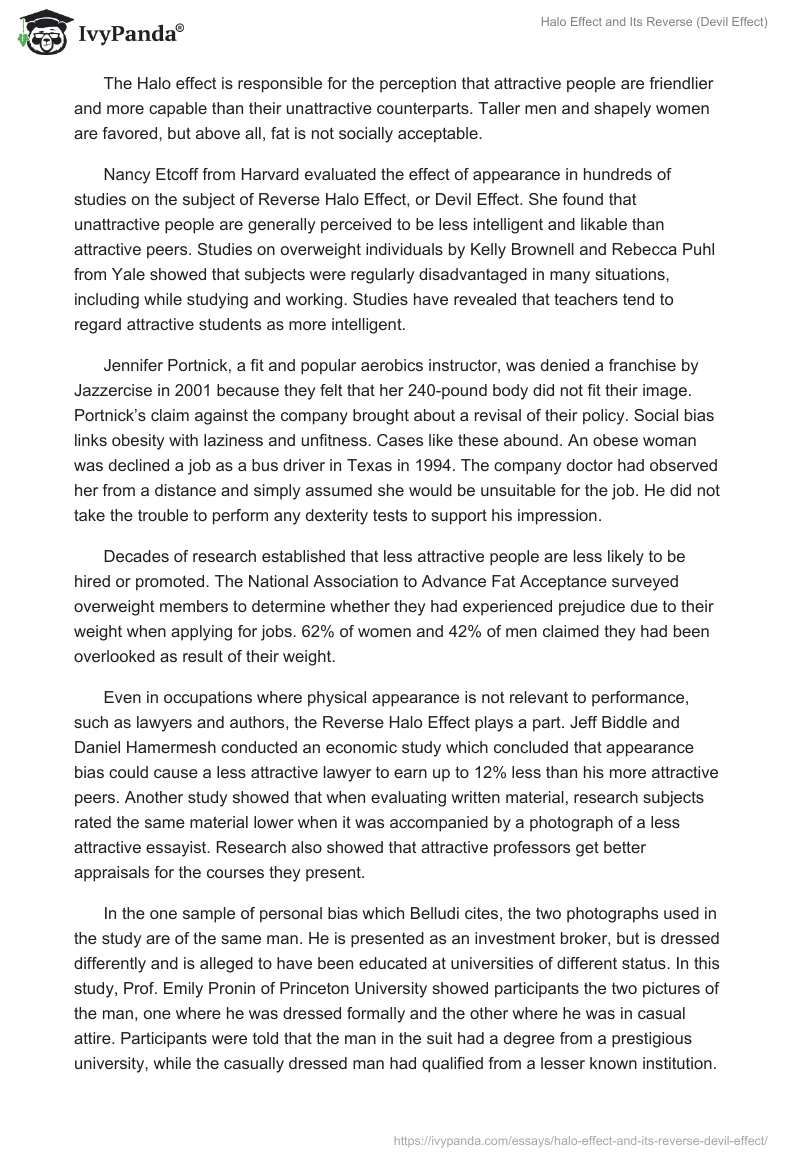In a perfect world, nobody would suffer prejudice on the basis of gender, ethnicity, class, age or sexual orientation. Popular society may claim to strive towards this goal. They may even pass laws to prohibit such discrimination. Yet most people’s opinions of others are subject to appearance-related bias. (Rhode 2010)
The effects of appearance-related bias may either favor or hamper the subject. For example, a favorable impression based on one quality may lead to the assumption of other positive qualities – the Halo Effect – or an unfavorable impression based on one or two negative qualities could lead to the assumption of more bad qualities – the Horns (Devil) Effect. (Belludi, 2010)
Nagesh Belludi’s article, “Beware of the Halo and Horns Effects” describes potential errors in judgment due to positive or negative bias, while in her article “Why Looks Are the Last Bastion of Discrimination”, Deborah L. Rhode concentrates on the negative influences of appearance-related bias, based exclusively on relative attractiveness.
Rhode’s article describes many research studies and illustrative cases of prejudice towards less attractive people. These can also be seen as examples of Belludi’s Devil Effect (Horns Effect).
Appearance-related bias intensifies prejudice based on disadvantages such as ethnicity and gender. During the late 1950’s, employers in the Southern states claimed that their white customers would cease to support them if they employed blacks. Several more recent, independent researchers have found that European facial features and hairstyles, and lighter skin tones, are generally considered more attractive.
The perception that men are better at most jobs, especially in mathematical and technical fields, is well illustrated by the case of Hedy Lamarr, the beautiful actress who invented Wi-Fi in the 1940’s. This accomplishment was dismissed for many years due to her gender, beauty and recognized occupation. (Cowan, 2012) Conversely, there have been cases of bias in favor of females. 40 – 50 years ago, only female flight attendants were employed by major airlines, ostensibly because the majority of their customers were businessmen who preferred being served by attractive females.
The Halo effect is responsible for the perception that attractive people are friendlier and more capable than their unattractive counterparts. Taller men and shapely women are favored, but above all, fat is not socially acceptable.
Nancy Etcoff from Harvard evaluated the effect of appearance in hundreds of studies on the subject of Reverse Halo Effect, or Devil Effect. She found that unattractive people are generally perceived to be less intelligent and likable than attractive peers. Studies on overweight individuals by Kelly Brownell and Rebecca Puhl from Yale showed that subjects were regularly disadvantaged in many situations, including while studying and working. Studies have revealed that teachers tend to regard attractive students as more intelligent.
Jennifer Portnick, a fit and popular aerobics instructor, was denied a franchise by Jazzercise in 2001 because they felt that her 240-pound body did not fit their image. Portnick’s claim against the company brought about a revisal of their policy. Social bias links obesity with laziness and unfitness. Cases like these abound. An obese woman was declined a job as a bus driver in Texas in 1994. The company doctor had observed her from a distance and simply assumed she would be unsuitable for the job. He did not take the trouble to perform any dexterity tests to support his impression.
Decades of research established that less attractive people are less likely to be hired or promoted. The National Association to Advance Fat Acceptance surveyed overweight members to determine whether they had experienced prejudice due to their weight when applying for jobs. 62% of women and 42% of men claimed they had been overlooked as result of their weight.
Even in occupations where physical appearance is not relevant to performance, such as lawyers and authors, the Reverse Halo Effect plays a part. Jeff Biddle and Daniel Hamermesh conducted an economic study which concluded that appearance bias could cause a less attractive lawyer to earn up to 12% less than his more attractive peers. Another study showed that when evaluating written material, research subjects rated the same material lower when it was accompanied by a photograph of a less attractive essayist. Research also showed that attractive professors get better appraisals for the courses they present.
In the one sample of personal bias which Belludi cites, the two photographs used in the study are of the same man. He is presented as an investment broker, but is dressed differently and is alleged to have been educated at universities of different status. In this study, Prof. Emily Pronin of Princeton University showed participants the two pictures of the man, one where he was dressed formally and the other where he was in casual attire. Participants were told that the man in the suit had a degree from a prestigious university, while the casually dressed man had qualified from a lesser known institution. The results were that the man in formal attire was perceived to be more trustworthy and his credentials were more readily accepted than the credentials of the casually clothed man. Modern society associates smart dressing with success.
While attractive people are perceived to be talented and affable, the halo effect is not restricted to visible appearance. Persuasive people and eloquent orators are often noticed and believed, and ascend faster than their more inhibited peers.
Halo effects and devil effects do not only apply to people. The positive reaction to Apple’s iPod created the belief that all Apple’s iPods and iPhones would be good. On the other hand, local car manufacturers have suffered due to the illusion that their products are inferior to Japanese vehicles.
People can be trained to overcome biases and prejudices, but judgments are mostly made unconsciously, and are therefore not easy to recognize. Before reaching a conclusion about a person or an object, we must ensure that we have all the relevant facts to enable us to make an unbiased decision.
Works Cited
Belludi, Nagesh. “[Rating Errors] Beware of the Halo and Horns Effects.” Right Attitudes. 2010. Web.
Cowan, Lee. “HedyLamarr: Movie Star, Inventor of WiFi.” CBS Sunday Morning, 2012. Web.
Rhode, Deborah L. “Why Looks Are the Last Bastion of Discrimination.” The Washington Post 2010: B1. Web.


